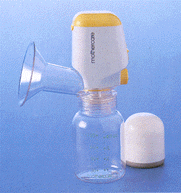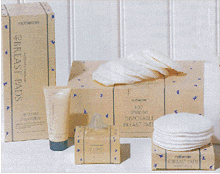15 February 2000 --
Merlene Michael
Mother's milk is, by definition, the most suitable food for a baby. Not only is it the most natural and nutritious way to feed your baby, but it protects your baby from illness, allergies and infections. One of the biggest advantages of breastfeeding is that you don't need any equipment. Nevertheless, there are products that are designed to make nursing more comfortable and convenient. Here's a checklist of what's best for the breast.
Breast pumps
Breast pumps allow for easy expressing and storage of breastmilk so that your baby can still have the best nutrition when you are away at work. Because breasts produce milk in response to demand, you may need to express milk in order to keep your supply going even if your baby does not latch on well at first.
Breast pumps are also useful when you want to provide milk for a premature or ill baby who can't be put to the breast, or when your breasts are uncomfortably engorged and you want to relieve the pressure. The best time to express milk is in the morning, when you will have the most milk.
Essentially, there are two types of breast pumps. Whichever type of pump you buy, it is essential that you clean and sterilise them before and after each use.
- Manual pumps. The lever creates suction as you pump with your hands. Buy one that is efficient, as it can be hard work.
- Electric pumps. These work by holding the funnel over the breast and drawing the plunger in and out, applying a rhythmical suction to the breast. They are efficient at obtaining substantial amounts of milk.
Expressing should be painless and you should stop immediately if there is any pain. It is also important to store your breastmilk correctly as it can go sour and make your baby ill. Refrigerate or freeze your milk as soon as you have expressed it. Refrigerated milk will keep for 24 hours while frozen milk keeps for up to six months. Milk storage kits with bags, clips and freezer labels make storage easier.
Nursing bras
Nursing bras are designed for the sole purpose of breastfeeding, so convenience and comfort should be on the top of your list when shopping for one. Wait until the last trimester of your pregnancy ninth month of pregnancy - from around the seventh month - before you shop for nursing bras because you are more likely to choose one that will fit adequately even after the baby is born.
Sizing is important because a good bra will minimise discomfort if your breasts become sore. An ill-fitting bra can also interfere with your milk production by blocking the ducts. Most good department stores have fitters who are professionally trained to assist you in finding the most suitable bra. Other features to look for:
- wide shoulder straps that don't cut into the skin
- broad side panels and a deep band beneath the cups for support
- high cotton content or fabric with breathable qualities that don't trap moisture and cause irritation to the skin
- fastening that is adjustable for comfort
- drop-front or zipper front bras that are easy to undo with one hand while you hold your baby.
You will need at least two or three nursing bras because you are constantly producing milk. Night time nursing bras are also available. Instead of the usual ways of opening for feeding, night time bras usually have a crossover front design so you can easily slip your breast out. And, they are lighter to wear.
Nursing garments
The right garments allow you to breastfeed discreetly in public. Breastfeeding garments usually feature vertical side openings and other ingenious ideas to make nursing a breeze. Pyjamas or gowns with a row of buttons in front are perfect for nighttime feeds.
Breast pads
Nursing breasts leak, and breast pads are designed to soak up the excess milk that flows between feeds. Most brands of breast pads are disposable, but you can get washable ones, which are usually sold in packs of 20, 40, or 100. Simply slip them into the cups of your bra to help you keep dry, clean and comfortable as well as prevent embarrassing stains that might otherwise come through your clothing.
In the early weeks of breastfeeding, you will go through lots of breast pads as the milk flow is vigorous. A 'wet breast' can make your nipples sore, so change the pads at least every morning, night and after each feed. You may not need breast pads at all once your milk production has settled.
Nipple protection
Sore nipples are one of the most common reasons why mothers give up breastfeeding. There are several ways to avoid the discomfort, but many mums find smearing a little breast milk over the nipples after a feed and leaving the breasts to dry naturally just as effective. It also helps to ensure your baby is latched on correctly. Avoid excessive washing of your breasts - one wash per day with warm water and soap is sufficient -as it strips the skin of its natural protective oil.

- Nipple creams. These are designed to soothe, moisturise and relieve sore nipples. If they are cracked, calendula or camomile cream may be helpful. Remember to gently remove traces of the cream on your nipple before you start a feed.
- Breast shells. These are plastic, shell-shaped containers that are used to collect milk dripping from one breast while you are feeding with the other. Breast shells are not essential, but they will help keep your nipples clean and dry. They also allow you to store the excess milk flow.
- Nipple shields. If your nipples bleed because of the cracking, a nipple shield may provide temporary relief. Made of soft, yet strong silicone, it fits over your nipple snugly. Your baby can then suck through a small rubber nipple on the front. However, nipple shields should only be used as a short-term solution as they can cut the milk flow by half and some babies may not receive adequate nutrition as a result.
- Niplette. For mothers with inverted nipples, this device should only be used in consultation with a lactation counsellor.
Nursing pillow
Good pillow support can make the difference between a healthy back and a sore one. There are pillows that are specially designed to go around your waist to provide a platform for your baby to lie on while he nurses. Others fit on your arm like a sleeve so that your baby's neck and head are supported while your other hand is free to nurse with ease.
References:
- Stoppard, Miriam, M.D., 1998. The New Parent: The Essential Guide for all First-Time Mothers & Fathers, Great Britain: Dorling Kindersley Limited, p.72 & 73
- Stoppard, Miriam, M.D., 1995. Complete Baby and Child Care (1st American Ed.), Great Britain: Dorling Kindersley Limited, p.44-47
Pictures courtesy of Mothercare.
Date reviewed: 07/01/2005